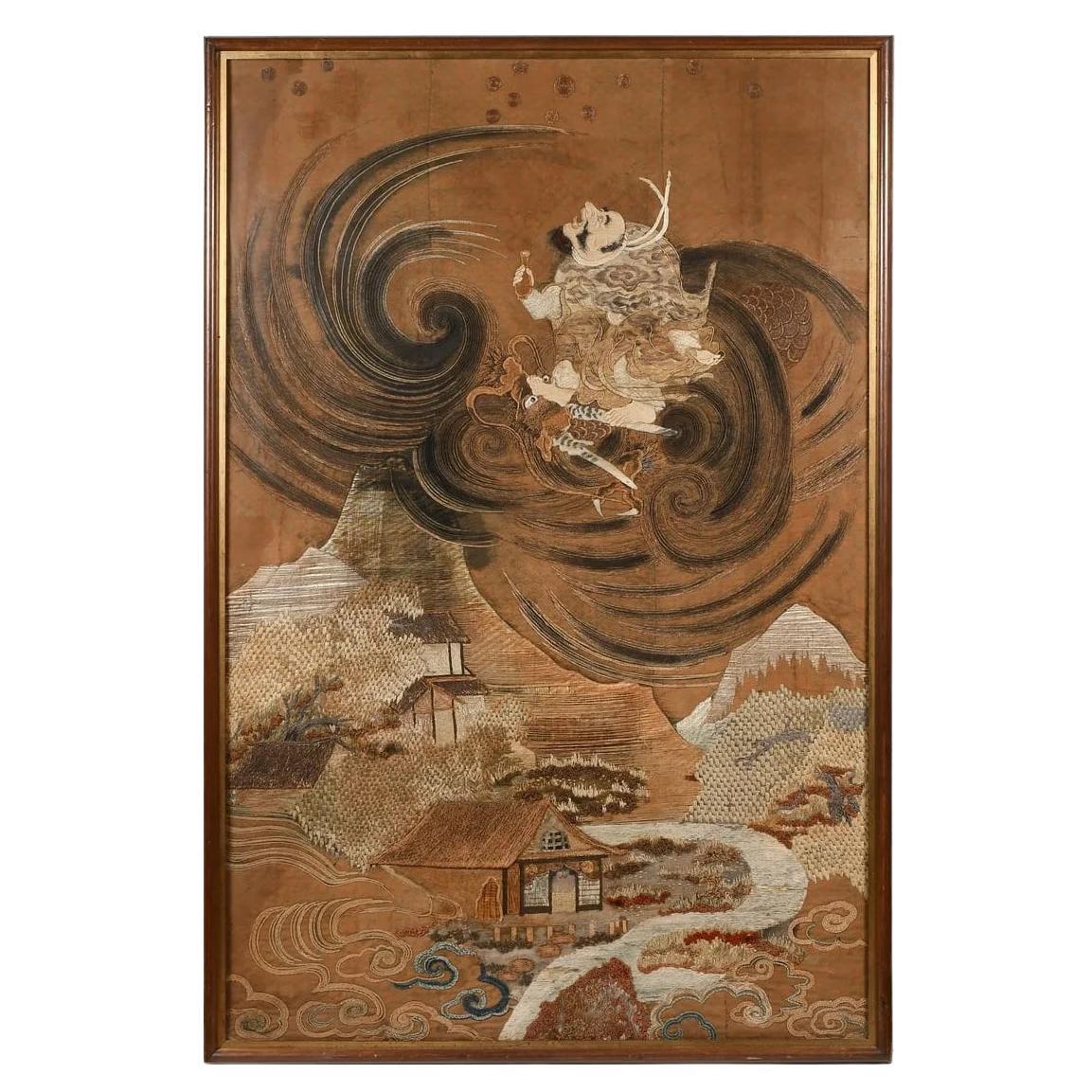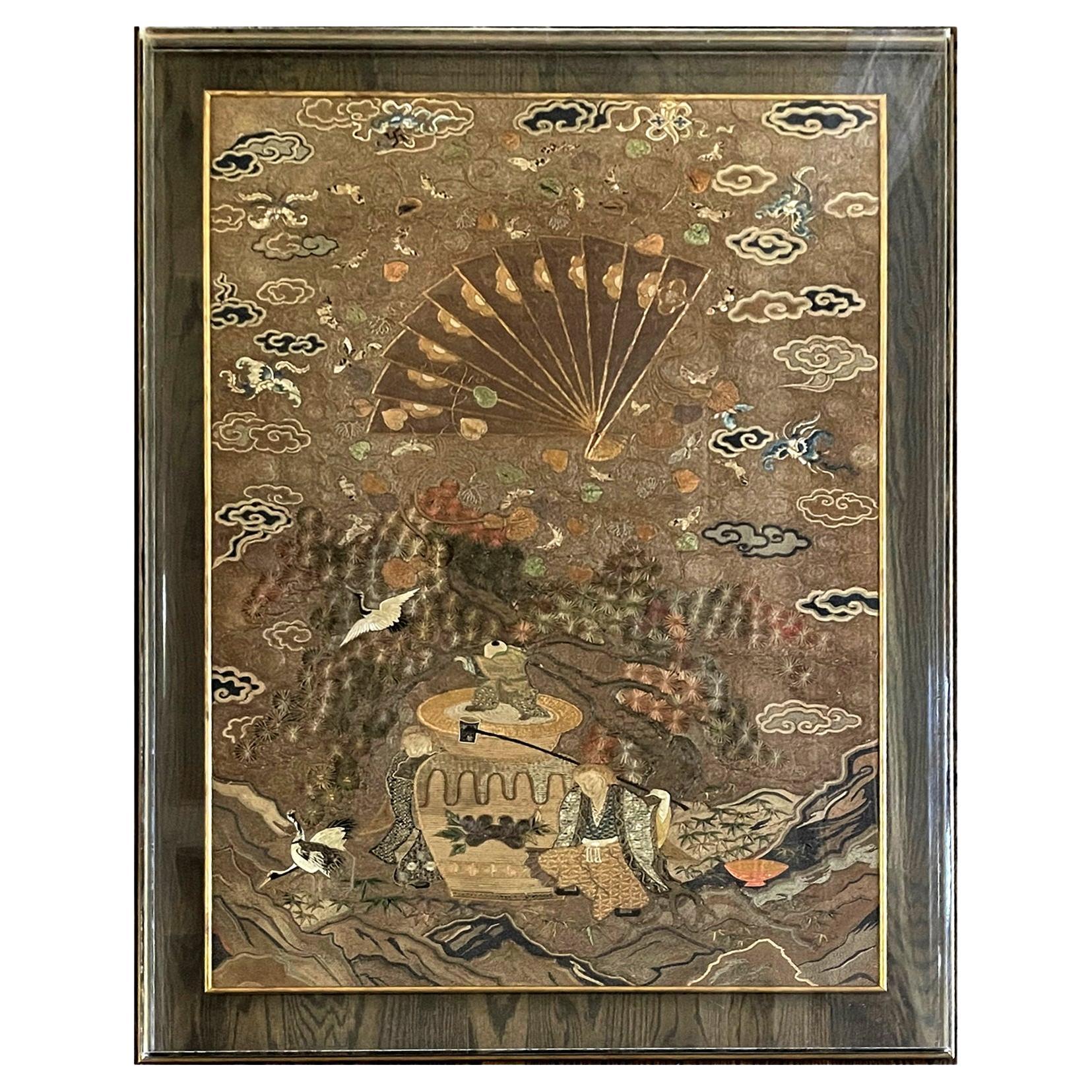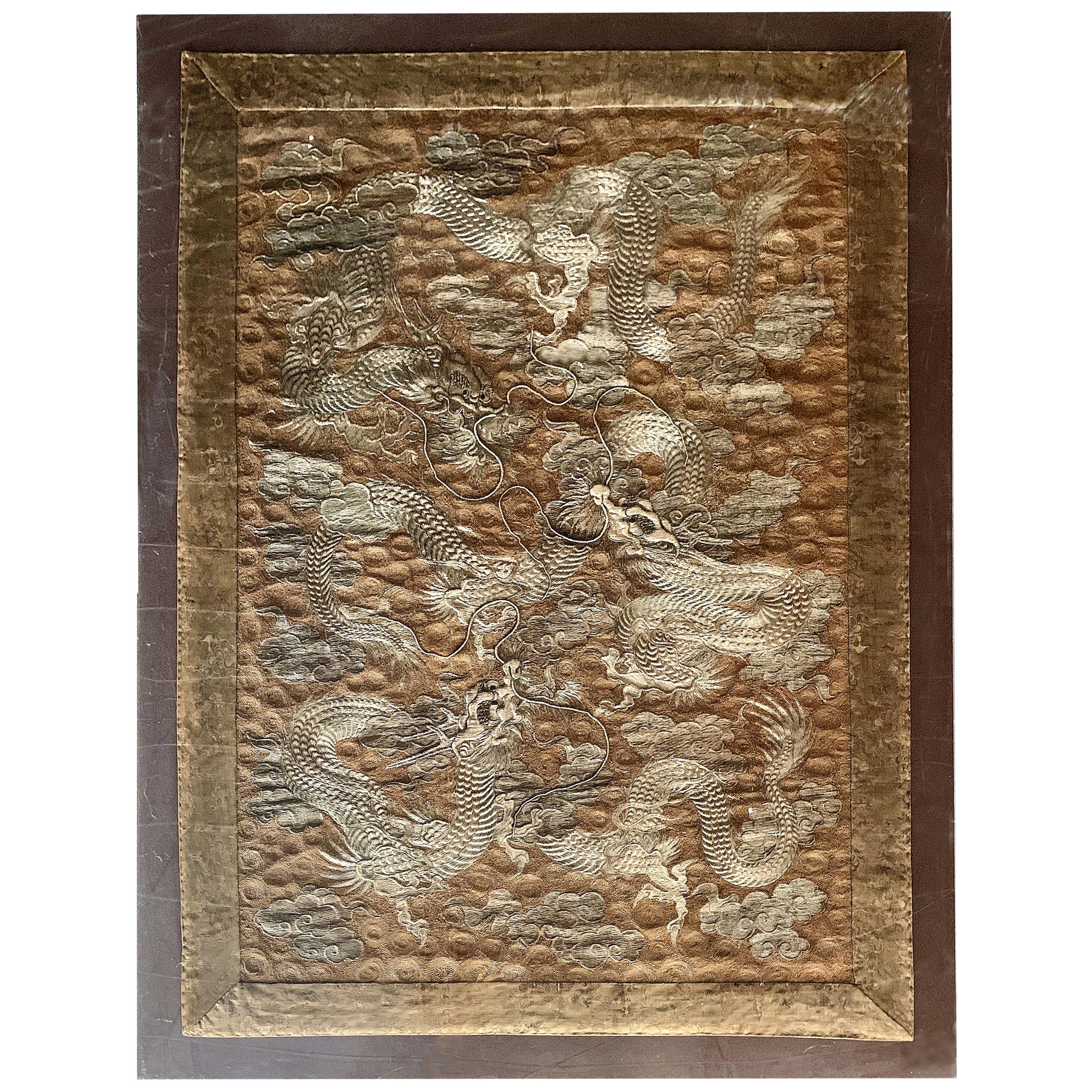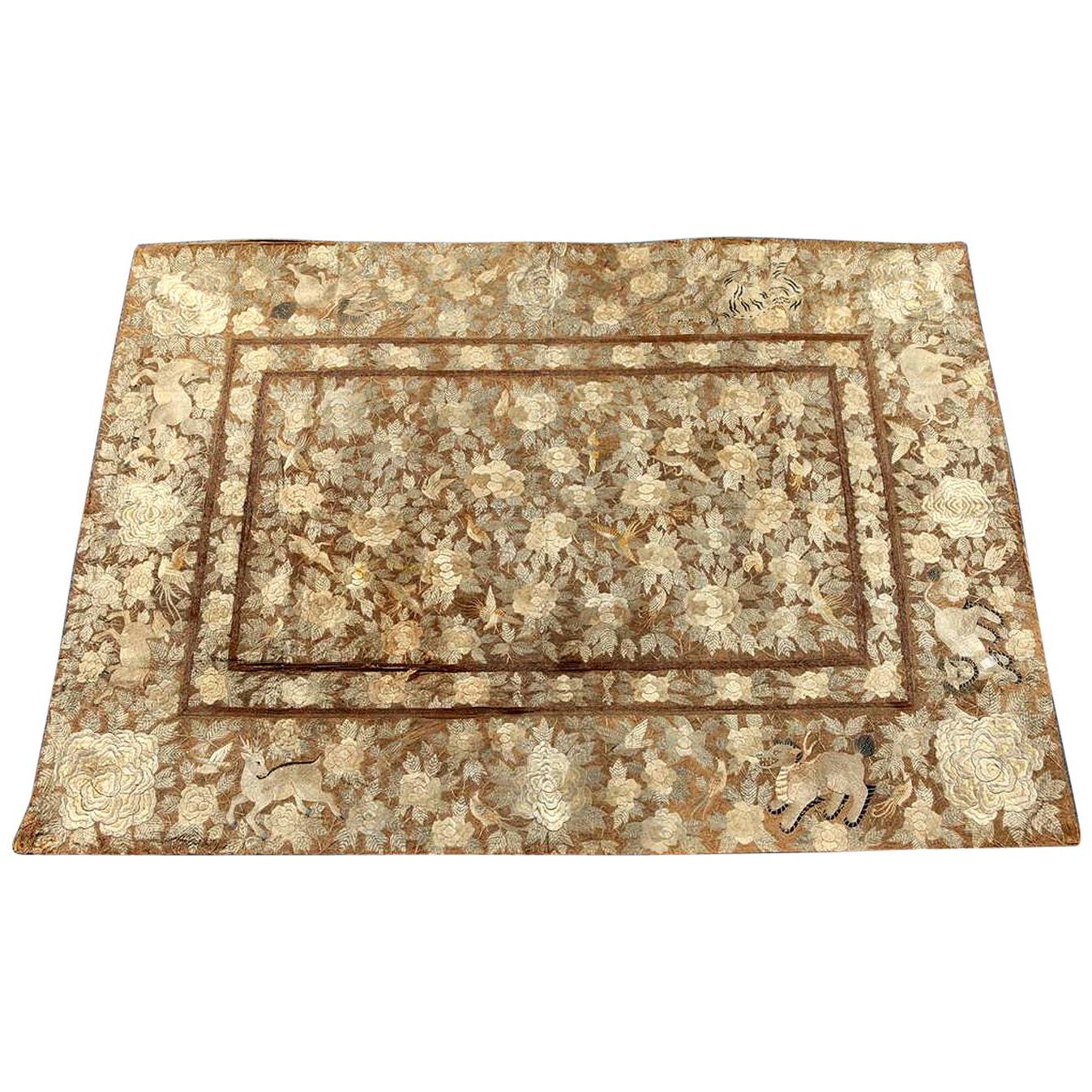Items Similar to Framed Japanese Antique Phoenix Dragon Embroidery Tapestry Meiji Period
Want more images or videos?
Request additional images or videos from the seller
1 of 15
Framed Japanese Antique Phoenix Dragon Embroidery Tapestry Meiji Period
About the Item
A visually stunning Japanese embroidery tapestry circa 1890s-1900s late Meiji period, presented with a linen matt with gold trim in a gilt wood frame. The design showcases a flying phoenix with splendid plumage above a torii gate rising from the water and a dragon slithering in the waves below. The torii gate bisects the image into the heaven above and the ocean below, and the background is filled respectively with scrolling clouds and stylized waves. The torii gates are commonly found at the entrances of Shinto shrines, as a threshold landmark for the transition from the mundane to the sacred. While the dragon does not represent the emperor in general as in Chinese culture, it is worshipped as a water deity in Japan. The phoenix, an auspicious symbol similar to its Chinese counterpart Fenghuang, represents the Japanese empress descended from heaven. The craftsmanship of this piece is superb. The high relief effect, created by meticulous techniques such as satin stiches, couching and piling with layers of gold and silver wrapped threads, displays a harmonious composition while conveying a livid sense of motion, and this set the piece apart as a highly collectible textile art.
Japanese textiles from Meiji period were widely exhibited in the west during turn of the 20th century at the international expositions. It was used to showcase the Japanese aesthetics with the techniques at their pinnacle. These expositions solidified the country's images overseas and fueled the Japonisme craze in the west, which turned out to be a long lasting influence on the western art. Many pieces were purchased and stayed in the west. It is likely this estate piece was from one of the expositions based on its high quality.
For a tapestry of phoenix, see "Threads of silk and gold ornamental textile from Meiji Japan Ashmolean", page 95.
A tapestry of dragon see "Re-envisioning Japan Meiji Fine Art Textile, John E. Vollmer", page 42-44.
For detailed terminology of embroidery techniques used in this work, please refer to threads of silk and gold ornamental textile from Meiji Japan Ashmolean page 86-87.
- Dimensions:Height: 53 in (134.62 cm)Width: 34.25 in (87 cm)Depth: 0.7 in (1.78 cm)
- Style:Japonisme (Of the Period)
- Materials and Techniques:
- Place of Origin:
- Period:
- Date of Manufacture:1890s-1910s
- Condition:Wear consistent with age and use. Textile appears very fine, not examined out of the frame. Completely newly framed with new glass.
- Seller Location:Atlanta, GA
- Reference Number:1stDibs: LU945022967012
About the Seller
5.0
Platinum Seller
These expertly vetted sellers are 1stDibs' most experienced sellers and are rated highest by our customers.
Established in 2006
1stDibs seller since 2010
478 sales on 1stDibs
Typical response time: <1 hour
- ShippingRetrieving quote...Ships From: Atlanta, GA
- Return PolicyA return for this item may be initiated within 2 days of delivery.
More From This SellerView All
- Framed Japanese Antique Embroidery Sennin Tapestry Meiji PeriodLocated in Atlanta, GAA stunning Japanese embroidery tapestry circa 1880s-1900s from late Meiji period, presented with an original wood frame with inner gold trim. The tour-de-force embroidered tapestry s...Category
Antique 1890s Japanese Meiji Textiles
MaterialsGiltwood, Silk
- Large Japanese Embroidery Tapestry Meiji PeriodLocated in Atlanta, GAA large and finely embroidered Japanese tapestry with brocade border, circa 1900s Meiji period. The tapestry depicts, in a rather realistic style, a forested landscape in autumn flan...Category
Early 20th Century Japanese Japonisme Textiles
MaterialsBrocade, Silk
- Japanese Silk Embroidery Tapestry Meiji PeriodLocated in Atlanta, GAA spectacular Japanese embroidered silk panel beautifully presented in a gilt frame suspended in a lucite shadow box with gilt wood border. The silk picture is dated to 1890-1910s toward the end of Meiji Period, when Japanese started to participate international expose by presenting its best art and craft. Elaborate embroidered silk tapestry like this was very popular among westerners due to its superb craftmanship and also exotic subject matter that was often derived from classic Japanese folklore, mythology and various motifs. The tapestry on offer is such an example. It depicts an old couple...Category
Antique 1890s Japanese Japonisme Textiles
MaterialsFabric, Silk, Lucite
- Large Framed Japanese Embroidery Dragon TapestryLocated in Atlanta, GAAn impressive Japanese embroidery tapestry circa 1890s Meiji period, presented with brocade border on linen canvas in a Lucite shadow box. The stunning design features three dragons coiling and flying in the clouds. The high relief technique used to render the dragons using mostly the silver threads gives this piece a tremendous sense of motion. The most auspicious mythological creature in Japan and China, dragons were a very popular motif in textile art. In this particular piece, it is the impressive size, the superb craftsmanship, the profuse use of silver threads and near perfect condition that set it apart. Japanese Meiji textiles were widely exhibited in the west during turn of the 20th century at the international exposition. It was used to showcase the Japanese aesthetics with the techniques at their pinnacle. These expositions solidified the country's images overseas and felled the Japanese craze in the west, which turned out to be a long-lasting influence on the western art. Many pieces were purchased and stayed in the west. It is likely this estate piece was from one of the expositions based on its high quality. For two similar dragon tapestries...Category
Antique 1890s Japanese Japonisme Textiles
MaterialsTextile, Lucite
- Massive Japanese Embroidery Tapestry Display Box Meiji PeriodLocated in Atlanta, GAA massive Japanese embordered tapestry professionally displayed in a custom acrylic shadow box. The fine work of textile art is dated to 1890-1920s, late Meiji (1868-1912) or possibl...Category
Early 20th Century Japanese Japonisme Textiles
MaterialsBrocade, Silk, Acrylic
- Antique Japanese Embroidery TapestryLocated in Atlanta, GAA large Japanese silk embroidery tapestry circa 19th century, late Edo to early Meiji period. Meticulously handwork that densely depicts repea...Category
Antique 19th Century Japanese Japonisme Textiles
MaterialsSilk
You May Also Like
- Late Meiji Period Sleeping Kimono / Yogi, JapanLocated in Point Richmond, CALate Meiji Period sleeping Kimono / Yogi, Japan Yogi are a type of oversized sleeping kimono traditionally used in Japan. This kimono would have b...Category
Early 20th Century Japanese Tribal Textiles
MaterialsCotton
- Meiji Period Japanese Indigo Double Ikat Futon CoverLocated in Point Richmond, CAMeiji period Japanese Indigo double ikat futon cover Japanese futon cover, a double ikat pattern in four panels depicting Kumamoto Castle with im...Category
Antique 1890s Japanese Meiji Textiles
MaterialsCotton
- Antique Early 20th Century Japanese Hand Stitched Silk Framed TapestryLocated in Lambertville, NJAll hand work framed silk Japanese tapestry with embroidered boarder. A deep custom black lacquered frame. Originaly sold from Newman Galleries....Category
Early 20th Century Japanese Meiji Textiles
MaterialsSilk, Glass, Lacquer
- Susani Uzbek Embroidery TapestryLocated in Alessandria, PiemonteOld very elegant "susani" from Uzbekistan - not too large, it's perfect for wall like a picture or a tapestry; else placed on a table or on the back of a sofa. ref. B/2433.Category
21st Century and Contemporary Uzbek Other Textiles
MaterialsSilk
- Antique Kalagas Burmese Wall Tapestry set in a Custom Newer FrameLocated in Douglas Manor, NY3797 Folk Art wall decoration /tapestry Hand sewn with beaded sequins and glass balls on dyed cloth Mounted on acrylic panel with gilt wood frame(old piece mounted at later date) Ta...Category
Antique 19th Century Asian Tapestries
MaterialsFabric, Acrylic, Beads
- Japanese Indigo Dyed Old Embroidery Cloth / Japanese Toy Pattern / 1912-1960Located in Sammu-shi, ChibaIt is a Japanese indigo dyed antique cloth. It calls its name "fu-ro-shi-ki". Originally used in the dressing room of the public bath "furo" during the...Category
Early 20th Century Japanese Showa Textiles
MaterialsCotton





